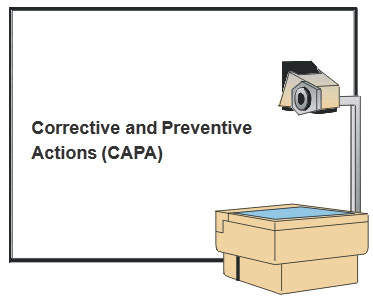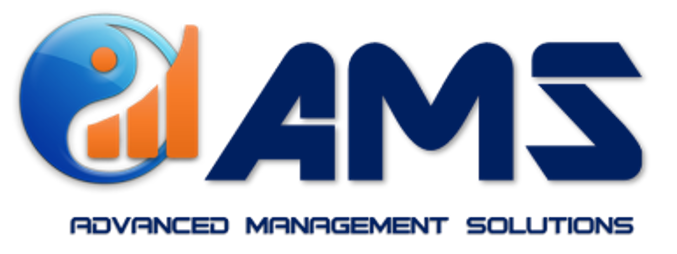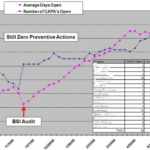
- Inspectional Objectives
- Decision Flow Chart
- Narrative
- Medical Device Reporting
- Inspectional Objectives
- Decision Flow Chart
- Narrative
- Corrections & Removals
- Inspectional Objectives
- Decision Flow Chart
- Narrative
- Medical Device Tracking
- Inspectional Objectives
- Decision Flow Chart
- Narrative
Corrective and Preventive Actions (CAPA)
Inspectional Objectives
- Verify that CAPA system procedure(s) that address the requirements of the quality system regulation have been defined and documented.
- Determine if appropriate sources of product and quality problems have been identified. Confirm that data from these sources are analyzed to identify existing product and quality problems that may require corrective action.
- Determine if sources of product and quality information that may show unfavorable trends have been identified. Confirm that data from these sources are analyzed to identify potential product and quality problems that may require preventive action.
- Challenge the quality data information system. Verify that the data received by the CAPA system are complete, accurate and timely.
- Verify that appropriate statistical methods are employed (where necessary) to detect recurring quality problems. Determine if results of analyses are compared across different data sources to identify and develop the extent of product and quality problems.
- Determine if failure investigation procedures are followed. Determine if the degree to which a quality problem or nonconforming product is investigated is commensurate with the significance and risk of the nonconformity. Determine if failure investigations are conducted to determine root cause (where possible). Verify that there is control for preventing distribution of nonconforming product.
- Determine if appropriate actions have been taken for significant product and quality problems identified from data sources.
- Determine if corrective and preventive actions were effective and verified or validated prior to implementation. Confirm that corrective and preventive actions do not adversely affect the finished device.
- Verify that corrective and preventive actions for product and quality problems were implemented and documented.
- Determine if information regarding nonconforming product and quality problems and corrective and preventive actions has been properly disseminated, including dissemination for management review.

Corrective and Preventive Actions (CAPA)
Narrative
The purpose of the corrective and preventive action subsystem is to collect information, analyze information, identify and investigate product and quality problems, and take appropriate and effective corrective and/or preventive action to prevent their recurrence. Verifying or validating corrective and preventive actions, communicating corrective and preventive action activities to responsible people, providing relevant information for management review, and documenting these activities are essential in dealing effectively with product and quality problems, preventing their recurrence, and preventing or minimizing device failures. One of the most important quality system elements is the corrective and preventive action subsystem.
 1. Verify that CAPA system procedure(s) that address the requirements of the quality system regulation have been defined and documented.
1. Verify that CAPA system procedure(s) that address the requirements of the quality system regulation have been defined and documented.
Review the firm’s corrective and preventive action procedure. If necessary, have management provide definitions and interpretation of words or terms such as “nonconforming product”, “quality audit”, “correction”, “prevention”, “timely”, and others. It is important to gain a working knowledge of the firm’s corrective and preventive action procedure before beginning the evaluation of this subsystem.
 NOTE: Corrective action taken to address an existing product or quality problem should include action to:
NOTE: Corrective action taken to address an existing product or quality problem should include action to:
Correct the existing product nonconformity or quality problems and; Prevent the recurrence of the problem.
The CAPA procedure should include procedures for how the firm will meet the requirements for all elements of the CAPA subsystem. All procedures should have been implemented.
Once you have gained a knowledge of the firm’s corrective and preventive action procedure, begin with determining if the firm has a system for the identification and input of quality data into the CAPA subsystem. Such data includes information regarding product and quality problems (and potential problems) that may require corrective and/or preventive action.
 2. Determine if appropriate sources of product and quality problems have been identified. Confirm that data from these sources are analyzed to identify existing product and quality problems that may require corrective action.
2. Determine if appropriate sources of product and quality problems have been identified. Confirm that data from these sources are analyzed to identify existing product and quality problems that may require corrective action.
The firm should have methods and procedures to input product or quality problems into the CAPA subsystem. Product and quality problems should be analyzed to identify product and quality problems that may require corrective action.
The firm should routinely analyze quality data regarding product and quality problems. This analysis should include data and information from all acceptance activities, complaints, service, and returned product records. Determine if the firm is capturing and analyzing data from acceptance activities relating to component, in-process and finished device testing. Information obtained subsequent to distribution, which includes complaints, service activities and returned products, as well as information relating to concessions (quality and nonconforming products), quality records, and other sources of quality data should also be captured and analyzed. Examples of other sources of quality data include quality audits, installation reports, lawsuits, etc.
 NOTE: In accordance with Agency policy (CPG 7151.02), do not request records regarding the results of internal quality audits, management reviews, third party audits (including ISO audits), or supplier audits. However, you will be reviewing raw data that is used by the firm when conducting their quality audits, management reviews, etc. Trending information and results of analyses are generally part of evaluations under the corrective and preventive action requirements. This information is utilized in internal audits and management reviews. Information or data utilized in internal audits and management reviews are considered raw data and should be available for routine review.
NOTE: In accordance with Agency policy (CPG 7151.02), do not request records regarding the results of internal quality audits, management reviews, third party audits (including ISO audits), or supplier audits. However, you will be reviewing raw data that is used by the firm when conducting their quality audits, management reviews, etc. Trending information and results of analyses are generally part of evaluations under the corrective and preventive action requirements. This information is utilized in internal audits and management reviews. Information or data utilized in internal audits and management reviews are considered raw data and should be available for routine review. 3. Determine if sources of product and quality information that may show unfavorable trends have been identified. Confirm that data from these sources are analyzed to identify potential product and quality problems that may require preventive action.
3. Determine if sources of product and quality information that may show unfavorable trends have been identified. Confirm that data from these sources are analyzed to identify potential product and quality problems that may require preventive action.
Determine if the firm is identifying product and quality problems that may require a preventive action. This can be accomplished by reviewing historical records such as trending data, corrective actions, acceptance activities (component history records, process control records, finished device testing, etc.) and other quality system records for unfavorable trends. Review if preventive actions have been taken regarding unfavorable trends recognized from the analysis of product and quality information. Product and quality improvements and use of appropriate statistical process control techniques are evidence of compliance with the preventive action requirement.
Determine if the firm is capturing and analyzing data regarding in-conformance product. Examples include capturing and analyzing component test results to detect shifts in test results that may indicate changes in vendor processes, component design or acceptance procedures. Identification of these indicators may necessitate a vendor investigation as a preventive action. Monitoring in-process and finished device test results may reveal additional indicators of potential quality problems. For devices where stability is an issue, test results of reserve samples are continually monitored. These monitoring activities may trigger process changes, additional training activities and other changes required to maintain the process within its tolerances and limits.
Determine if the firm is using statistical control techniques for process controls where statistical techniques are applicable. An example would be “Statistical Process Control” (SPC). SPC is utilized to monitor a process and initiate process correction when a process is drifting toward a specification limit. Typically, SPC activities are encountered with large volume production processes such as plastic molding and extrusion. Any continuing product improvements (in the absence of identified product problems such as non-conforming product) are also positive indicators of preventive actions.
 Important linkages for this activity include 820.70 Production and Process Controls and 820.250 Statistical Techniques.
Important linkages for this activity include 820.70 Production and Process Controls and 820.250 Statistical Techniques.
 4. Challenge the quality data information system. Verify that the data received by the CAPA system are complete, accurate and timely.
4. Challenge the quality data information system. Verify that the data received by the CAPA system are complete, accurate and timely.
Select one or two quality data sources. Using the sampling tables, review records from the chosen data sources to determine if the data were entered into the CAPA system. In addition, determine whether the data are complete, accurate and entered into the CAPA system in a timely manner.
 Important linkages for this activity include 820.80 Acceptance Activities, 820.90 Nonconforming Product, 820.170 Installation, 820.198 Complaint Files and 820.200 Servicing.
Important linkages for this activity include 820.80 Acceptance Activities, 820.90 Nonconforming Product, 820.170 Installation, 820.198 Complaint Files and 820.200 Servicing.
 5. Verify that appropriate statistical methods are employed (where necessary) to detect recurring quality problems. Determine if results of analyses are compared across different data sources to identify and develop the extent of product and quality problems.
5. Verify that appropriate statistical methods are employed (where necessary) to detect recurring quality problems. Determine if results of analyses are compared across different data sources to identify and develop the extent of product and quality problems.
The analysis of product and quality problems should include appropriate statistical and non-statistical techniques. Statistical techniques include Pareto analysis, spreadsheets, and pie charts. Non-statistical techniques include quality review boards, quality review committees and other methods.
The analysis of product and quality problems should also include the comparison of problems and trends across different data sources to establish a global, and not an isolated view, of a problem. For example, problems noted in service records should be compared with similar problem trends noted in complaints and acceptance activity information.
The full extent of a problem must be captured before the probability of occurrence, risk analysis and the proper course of corrective or preventive action can be determined.
 6. Determine if failure investigation procedures are followed. Determine if the degree to which a quality problem or nonconforming product is investigated is commensurate with the significance and risk of the nonconformity. Determine if failure investigations are conducted to determine root cause (where possible). Verify that there is control for preventing distribution of nonconforming product.
6. Determine if failure investigation procedures are followed. Determine if the degree to which a quality problem or nonconforming product is investigated is commensurate with the significance and risk of the nonconformity. Determine if failure investigations are conducted to determine root cause (where possible). Verify that there is control for preventing distribution of nonconforming product.
Review the firm’s CAPA procedures for conducting failure investigations. Determine if the procedures include provisions for identifying the failure modes, determining the significance of the failure modes (using tools such as risk analysis), the rationale for determining if a failure analysis should be conducted as part of the investigation, and the depth of the failure analysis.
Discuss with the firm their rationale for determining if a corrective or preventive action is necessary for an identified trend regarding product or quality problems. The decision process may be linked to the results of a risk analysis and essential device outputs.
Using the sampling tables, select failure investigation records regarding more than one failure mode (if possible) and determine if the firm is following their failure investigation procedures.
Confirm that all of the failure modes from your selected sample of failure investigations have been captured within data summaries such as reports, pie charts, spreadsheets, Pareto charts, etc.
Determine whether the depth of the investigation (where possible) is sufficient (root cause) to determine the corrective action necessary to correct the problem. Select one significant failure investigation that resulted in a corrective action and determine if the root cause had been identified so that verification or validation of the corrective action could be accomplished.
Using the sampling tables, review a number of incomplete failure investigations for potential unresolved product nonconformances and potential distribution of nonconforming product. Unresolved problems that could be of significant risk to the patient or user may require product recall if the problem cannot be resolved.
Using the sampling tables, review records regarding nonconforming product where the firm concluded corrective or preventive action was not necessary. As noted above, verify that the firm is not continuing to distribute nonconforming product. This may be an important deficiency based on the class of, and the risk associated with, the product.
 Important linkages for these activities include 820.20 Management Responsibility, 820.25 Training, 820.30 Design Controls, 820.90 Nonconforming Product and possibly 820.250 Statistical Techniques.
Important linkages for these activities include 820.20 Management Responsibility, 820.25 Training, 820.30 Design Controls, 820.90 Nonconforming Product and possibly 820.250 Statistical Techniques.
Using the sampling tables, review nonconforming product and quality concessions. Review controls for preventing distribution of nonconforming products. Product and quality concessions should be reviewed to verify that the concessions have been made appropriate to product risk, within the requirements of the quality system and not solely to fulfill marketing needs.
 Important linkages regarding these activities include 820.20 Management Responsibility and 820.90 Nonconforming Product.
Important linkages regarding these activities include 820.20 Management Responsibility and 820.90 Nonconforming Product.
 7. Determine if appropriate actions have been taken for significant product and quality problems identified from data sources.
7. Determine if appropriate actions have been taken for significant product and quality problems identified from data sources.
Where appropriate, this may include recall actions, changes in acceptance activities for components, in-process and finished devices, etc.
Using the sampling tables, select and review significant corrective actions and determine if the change or changes could have extended beyond the action taken. A significant action would be a product or process change to correct a reliability problem or to bring the product into conformance with product specifications. Discuss with the firm their rationale for not extending the action to include additional actions such as changes in component supplier, training, changes to acceptance activities, field action or other applicable actions. Investigators should discuss and evaluate these issues but be careful not to say anything that could be construed as requesting a product recall.
 8. Determine if corrective and preventive actions were effective and verified or validated prior to implementation. Confirm that corrective and preventive actions do not adversely affect the finished device.
8. Determine if corrective and preventive actions were effective and verified or validated prior to implementation. Confirm that corrective and preventive actions do not adversely affect the finished device.
Using the selected sample of significant corrective and preventive actions, determine the effectiveness of these corrective or preventive actions. This can be accomplished by reviewing product and quality problem trend results. Determine if there are any similar product or quality problems after the implementation of the corrective or preventive actions. Determine if the firm has verified or validated the corrective or preventive actions to ensure that such actions are effective and do not adversely affect the finished device.
Corrective actions must be verified and (if applicable) validated. Corrective actions must include the application of design controls if appropriate. Good engineering principles should include: establishing a verification or validation protocol; verification of product output against documented product requirements and specifications; ensuring test instruments are maintained and calibrated; and that test results are maintained, available and readable.
 Important linkages regarding this CAPA element include 820.30 Design Control and 820.70(b) Production and Process Control.
Important linkages regarding this CAPA element include 820.30 Design Control and 820.70(b) Production and Process Control.
 9. Verify that corrective and preventive actions for product and quality problems were implemented and documented.
9. Verify that corrective and preventive actions for product and quality problems were implemented and documented.
Using the sampling tables, select and review records of the most recent corrective or preventive actions (this sample may consist of or include records from the previously selected sample of significant corrective actions). To determine if corrective and preventive actions for product and quality problems and changes have been documented and implemented it may be necessary to view actual processes, equipment, facilities or documentation.
 10. Determine if information regarding nonconforming product and quality problems and corrective and preventive actions has been properly disseminated, including dissemination for management review.
10. Determine if information regarding nonconforming product and quality problems and corrective and preventive actions has been properly disseminated, including dissemination for management review.
Determine that the relevant information regarding quality problems, as well as corrective and preventive actions, has been submitted for management review. This can be accomplished by determining which records in a recent CAPA event were submitted for management review. Review the raw data submitted for management review and not the actual results of a management review.
Review the CAPA (and other procedures if necessary) and confirm that there is a mechanism to disseminate relevant CAPA information to those individuals directly responsible for assuring product quality and the prevention of quality problems.
Review information related to product and quality problems that has been disseminated to those individuals directly responsible for assuring product quality and the prevention of quality problems. Using the sample of records from Objective 9 above, confirm that information related to product and quality problems is disseminated to individuals directly responsible for assuring product quality and the prevention of quality problems.
Source: FDA.gov






